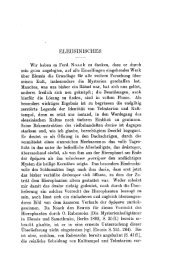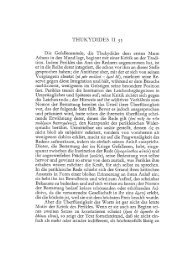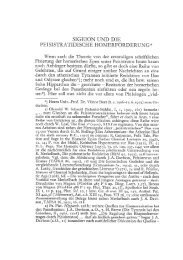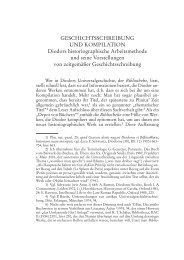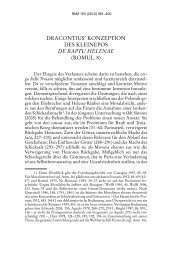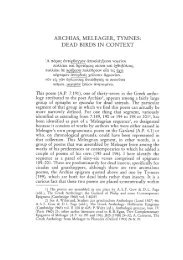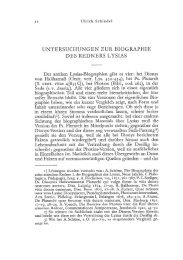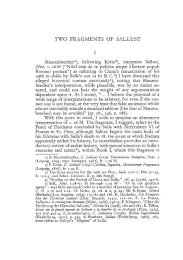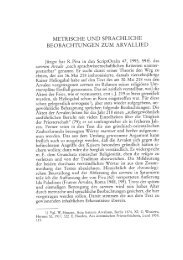APOTELESMATICA 2. (1) 14–140: SOURCES AND MODELS*
APOTELESMATICA 2. (1) 14–140: SOURCES AND MODELS*
APOTELESMATICA 2. (1) 14–140: SOURCES AND MODELS*
Create successful ePaper yourself
Turn your PDF publications into a flip-book with our unique Google optimized e-Paper software.
84 Maria Ypsilanti<br />
Manetho also seems to have in mind Schol. on Aratus 26, where the<br />
scholiast remarks that Aratus is using Oceanus to indicate the horizon<br />
and proceeds by saying that it kÊklƒ m¢n går tØn kayÉ ≤mçw<br />
per¤keitai ofikoum°nhn, §j aÈtoË d¢ ka‹ efiw aÈtÚn a· te dÊseiw ka‹<br />
éntola‹ g¤gnontai. Apot. <strong>2.</strong> (1) 112–3 is a poetical elaboration of<br />
this description, with line 113 clarifying the statement about the<br />
sun-risings and settings.<br />
The description of the Meridian and the Horizon by Pseudo-<br />
Manetho deserves a particular attention in regard to other points as<br />
well. It is interesting to notice that the author presents them as<br />
“unmoved and steady” (l. 107). Manilius says that these two circles<br />
“have wings”; 36 this notion is due to the fact that the Horizon and<br />
the Meridian are not the same for every place of Earth, but change<br />
position according to the viewer’s standpoint. 37 However there is<br />
no contradiction here: the two circles are unmoved because they do<br />
not participate in the circular movement of the sphere, their position<br />
being irrelevant to the position of the constellations, and for<br />
this reason are not depicted on the globes. 38 Of special interest is<br />
Pseudo-Manetho’s statement that the two circles begin “from the<br />
top of the axis” (implication of the Northern pole, l. 44) and “cut<br />
each other up to the Southern pole” (l. 45). The Meridian does pass<br />
from the poles. 39 But what about the assertion that the Horizon<br />
trial night; also cf. Geminus 5.54 ır¤zvn d° §sti kÊklow ı dior¤zvn ≤m›n tÒ te fanerÚn<br />
ka‹ tÚ éfan¢w m°row toË kÒsmou ka‹ dixotom«n tØn ˜lhn sfa›ran toË kÒsmou,<br />
Àste ≤misfa¤rion m¢n Íp¢r g∞w épolambãnesyai, ≤misfa¤rion d¢ ÍpÚ g∞n. Hyginus<br />
(4.3,3) mentions the Aratean passage (ll. 61 f.) in his discussion about the equator,<br />
which implies that he regards the Horizon as coinciding with the equator. This view,<br />
i. e. that the poets’ Ocean lies between the tropics, is criticised by Geminus, 16.22 ff.,<br />
see G. Aujac, Géminus, Introduction aux phénomènes (Paris 1975) ad loc.<br />
36) Hos volucris fecere duos, 1.633.<br />
37) Cf. Man. 1.637 ff., 661 f.; also Geminus 5.58 oÈ katå pçsan d¢ x≈ran ka‹<br />
pÒlin ı aÈtÒw §stin ır¤zvn, id. 5.66 oÈ katå pçsan d¢ x≈ran ka‹ pÒlin ı aÈtÒw §sti<br />
meshmbrinÒw.<br />
38) Cf. Gem. 5.62 oÈ katagrãfetai d¢ ı ır¤zvn §n ta›w sfa¤raiw diÉ afit¤an<br />
toiaÊthn, ˜ti ofl m¢n loipo‹ kÊkloi pãntew ferom°nou toË kÒsmou épÉ énatol∞w §p‹<br />
tØn dÊsin sumperistr°fontai ka‹ aÈto‹ ëma tª toË kÒsmou kinÆsei, ı d¢ ır¤zvn §st‹<br />
fÊsei ék¤nhtow tØn aÈtØn tãjin diafulãttvn diå pantÒw, 5.65 (the Meridian) ka‹<br />
oappletow d° §stin ı kÊklow ék¤nhtow §n t“ kÒsmƒ ka‹ tØn aÈtØn tãjin diafulãssvn<br />
§n ˜l˙ tª toË kÒsmou peristrofª. OÈ katagrãfetai d¢ oÈd¢ oappletow ı kÊklow §n ta›w<br />
kathsthrizom°naiw sfa¤raiw diå tÚ ka‹ ék¤nhtow e‰nai ka‹ mhdem¤an §pid°xesyai<br />
metãptvsin. See also Aujac (1993, La Sphéropéé) 166 f.<br />
39) Cf. for instance Gem. 5.64 MeshmbrinÚw d° §sti kÊklow ı diå t«n toË<br />
kÒsmou pÒlvn ka‹ toË katå korufØn shme¤ou grafÒmenow kÊklow.



